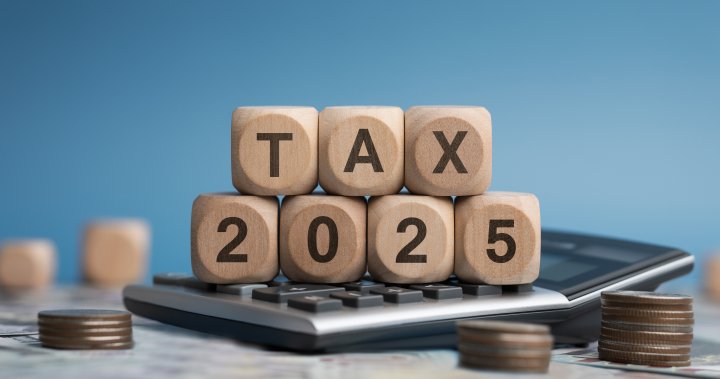Canada’s tax season is now officially open – and there a few key changes that could affect Canadian pocketbooks.
Starting Monday, Canadians can file their income tax and benefit returns online.
“Considering all of the financial stress the Canadians are feeling right now, this might be a good year to take a bit of a closer look at your taxes to make sure that you are claiming every single tax credit that’s available to you,” said Clay Jarvis, a financial expert with NerdWallet Canada.
The Canada Revenue Agency said it received more than 33 million returns last year and issued more than 19 million refunds – an average of $2,294.
The deadline for most individuals to file and pay any taxes owed is April 30 after which they may face penalties and interest.
Self-employed Canadians have until June 16 to file their tax return, but any money owed should be paid before April 30 to avoid interest, according to the CRA
Getting on top of your taxes early can pay off, especially if your tax situation is a bit more complicated, Jarvis said.
“I think sooner is always better when it comes to your taxes,” he said.
This will not only let people get a quicker refund, but also give more time to reach out to the CRA for help or track down receipts, Jarvis said
“Giving yourself a longer runway is going to make it a less stressful process and … you’re going to get your money a lot faster,” he said.

The federal income tax brackets are increasing by 2.7 per cent to account for inflation. That comes after a 4.7 per cent increase in 2024.
For 2025, federal tax is 15 per cent for earnings up to $57,375; 20.5 per cent between $57,375.01 and $114,750; and 26 per cent between $114,750.01 and $177,882.
The tax rate is 29 per cent for earnings between $177,882.01 and $253,414, while anything more than that is taxed at 33 per cent.
In addition, provinces and territories use their own personal income levels to calculate tax rates.
The contribution limit for the registered retirement savings plan (RRSP) has increased to $32,490 for the 2025 tax year, up from $31,560 the year before.

Get weekly money news
Get expert insights, Q&A on markets, housing, inflation, and personal finance information delivered to you every Saturday.
Maximum pensionable earnings and contributions have also gone up.
The Year’s Maximum Pensionable Earnings (YMPE) for 2025 will be $71,300 — up from $68,500 the previous year.
The maximum contribution for employee and employer Canada Pension Plan has increased to $4,034.10 each—up from $3,867.50 in 2024. But the contribution rate for 2025 remains unchanged at 5.95 per cent.
The self-employed CPP contribution rate remains at 11.90 per cent, and the maximum contribution will be $8,068.20—up from $7,735.00 in 2024, according to the CRA.
After two consecutives increases, the contribution room for the tax-free savings account (TFSA) will remain unchanged at $7,000.

For the 2025 tax year, the basic personal amount (BPA) — on which you do not pay federal income tax — ranges from $14,538 to $16,129, depending on your overall income.
That’s up from 2024 figures, which range from $14,256 to $15,705. Those with lower incomes have a higher basic personal tax credit.
As for Employment Insurance (EI), the maximum insurable earnings have increased to $65,700 – up from 63,200.
For 2025, the maximum annual EI premium that an employee will pay is 1,077.48 – increasing from 1,049.12 in 2024.
The maximum weekly EI benefit rate has also risen from $668 to $695 per week.

For the 2025 tax season, the CRA has made some updates to its website.
The federal tax agency said last month that it has “simplified its sign-in process, making it easier to access the My Account, My Business Account, and Represent a Client portals with a single sign in.”
CRA account holders can now access all services in My Account, My Business Account, and Represent a Client with one click as opposed to signing in separately, which was the case before.
CRA has also rolled out a new document verification service and an online chat function that let’s My Account users talk to a CRA agent if they run into any issues.
“If you’re going to do your taxes yourself, I think you should always be looking into whatever digital services are there, either from the CRA or a CRA-approved tax filing service,” Jarvis said.
More than two million Canadians will be able to file their taxes automatically this year.
The CRA said it is opening up its SimpleFile by Phone service to more Canadians this tax season, while also for the first time making a digital option available for people who have filed their taxes in recent years.
This free automatic tax filing service will be offered to “individuals with low or fixed incomes and simple tax situations that remain unchanged from year to year,” Déborah Cléry, a CRA spokesperson, told Global News last month.
She said the invitation letters to eligible Canadians will be sent out via mail or their CRA account over the next couple of months.
To find out more about how automatic tax filing works and who is eligible, read here.

Canadians don’t have to worry about capital gains tax changes — for now, at least.
Last month, the federal government announced that it was delaying plans to raise the inclusion rate on capital gains.
A planned hike to the capital gains inclusion rate will not be implemented until Jan. 1, 2026, pushing back the original date of June 25, 2024.
Jarvis said the delay will help wealthy Canadians save “a bunch of money” and it’s one less thing for them to worry about.
The CRA says it is working to update its systems to reflect the current inclusion rate of 50 per cent, but this update may not be completed in time when online filing becomes available Monday.
“If you are impacted by this situation, you may avoid processing delays by waiting until the updates are completed in the coming weeks before filing your income tax and benefit return,” the CRA said on its website.

People who worked from home should dig a little deeper to make sure they are getting as many tax credits and benefits as they can to either reduce their tax bill or increase their refund, Jarvis said.
Gig workers, especially those who are new to Canada, should try to familiarize themselves with the tax laws, he advised.
Lower-income gig workers could also get free tax advice from a tax clinic, he added.
What to do with your tax refund
Jarvis said tax refunds should not be treated as a gift and should be used responsibly, such as putting them toward a debt or in savings.
“If you do get a sizable tax refund, don’t treat it as a windfall. Don’t go out and blow it,” he said.
“This is really your own money that you’re getting back from the government.”
–with files from The Canadian Press






